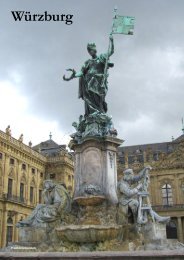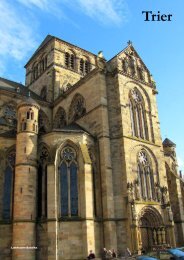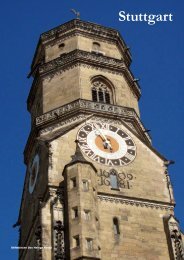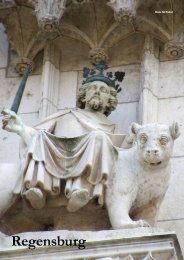BambergRaven
Create successful ePaper yourself
Turn your PDF publications into a flip-book with our unique Google optimized e-Paper software.
Bamberg<br />
Böttingerhaus
Bamberg<br />
Bamberg is one of Germany’s<br />
most beautiful cities and said to<br />
be set – like Rome – on seven<br />
hills. Fittingly, the church was<br />
the source of its influence and its<br />
patrons were emperors.<br />
Bamberg’s old town on the Regnitz was<br />
given UNESCO world heritage listing as an<br />
influential example of medieval layout, with<br />
its earliest churches forming a rough cross. Its<br />
structural heritage features a largely Romanesque<br />
cathedral, Renaissance and Baroque<br />
princely residences and well over 2000 listed<br />
buildings. Never walled, the episcopal seat<br />
was ransomed during the 15th century Hussite<br />
wars, narrowly avoided destruction in the<br />
Thirty Years War and suffered little World War<br />
II damage.<br />
The city grew around the castle of the<br />
Babenberg dukes of Franconia, whose<br />
origins were in west Frankish nobility. The<br />
Babenbergs had the worst of a long feud with<br />
the line of Conrad, later king of Germany,<br />
and were ousted in battle in 906, although the<br />
later margraves and dukes of Austria claimed<br />
descent from them.<br />
Bamberg’s relationships with the throne<br />
improved. The German king and later Holy<br />
Roman emperor Heinrich II founded the<br />
bishopric in 1007 with a view to spreading the<br />
faith eastward and establishing monastic life<br />
in the region. This, which involved taking over<br />
territory assigned to the Würzburg bishops, set<br />
the city on the path to greatness. Heinrich,<br />
devoted to the notion of monasticism, and his<br />
queen Kunigunde controlled extensive lands<br />
in the region and ensured the bishopric was<br />
richly endowed. Both were sanctified and are<br />
buried in the cathedral.<br />
Bamberg had its first great period under the<br />
Hohenstaufen emperors in the 12th century<br />
and was from the 13th century one of the<br />
biggest of Germany’s episcopal principalities.<br />
At times over succeeding centuries its bishop<br />
also held dominion over Würzburg (under the<br />
Schönborns) and Regensburg. When Bamberg<br />
joined Bavaria in 1802 the age of the princebishops<br />
was over, although the city later<br />
became the seat of an archbishopric.<br />
Over six centuries market gardening was<br />
thriving near the centre of the city, which<br />
became known for onion growing and<br />
viticulture. Brewing was also important, even<br />
to the monks of Michaelsberg, and today there<br />
are several breweries, each with several styles<br />
and labels.<br />
The imagination of the Bamberg resident<br />
E.T.A. Hoffmann impressed itself on the German<br />
Romantic movement through words and<br />
music and for several formative years he was<br />
the city theatre’s musical director. The theatre<br />
today retains the style of his period.<br />
Inselstadt<br />
The islands formed by the arms of the Regnitz<br />
and the Main-Donau-Kanal near the Main<br />
confluence were the basis of the citizens’<br />
quarter, while the clergy tended to occupy the<br />
higher hills. The division between the two was<br />
acknowledged in the unique siting of Altes<br />
Rathaus on the bridges over the left arm of the<br />
Regnitz.<br />
Today the city is centred on Maximilianplatz<br />
and Neues Rathaus: walk southwest<br />
on Grüner Markt past the Baroque St<br />
Martin and the Neptunbrunnen – beloved<br />
to the city as the Gabelmann (‘man with the<br />
fork’) – to the bridges over the Regnitz. It’s<br />
best to appreciate the Rathaus with its riot of<br />
colour from all available angles, and to walk<br />
around to Untere Brücke to visit the statue<br />
RAVEN QUICK GUIDE<br />
Tourist information: Geyerswörthstraße 5 (tel 0951-2976200, M-F 9.30-18, Sa 9.30-16,<br />
Su 9.30-14.30).<br />
Accommodation service: Geyerswörthstraße 5 (tel 0951-2976310, email reservierung@<br />
bamberg.info).<br />
Money: VR-Bank, Schönleinplatz (M-F 9-17); Sparkasse, Lange Straße 27 (M-W & F<br />
8-16.30, Th 8-18); Sparda-Bank, Lange Straße 19 (M & Th 9-12.45, 13.30-18, Tu-W<br />
9-12.45, 13.30-18, F 9-12.45).<br />
Lockers: Hauptbahnhof, platform 1 (€3.50/2.50 per day); ZOB (€0.30/0.20 for 4 hours).<br />
Transit information: STWB Kundencenter, ZOB, Promenadestraße 6A (tel 0951-774900,<br />
M-F 7-18).<br />
Post: Ludwigstraße 25 (M-F 9-18, Sa 9-12.30); Heinrichstraße 1 (M-F 8.30-17.30, Sa 9-12).<br />
Internet: ND*S Internet Cafe, Untere Königstraße 4 (M-W & F 8-18, Th 7-13, Sa 9-14).<br />
Laundry: SB-Waschsalon, Untere Königstraße 14 (M-Su 6-22).<br />
Police: tel 110; Schildstraße 81 (tel 0951-91290); Schranne 2 (tel 0951-9129240).<br />
Pharmacy: Martin-Apotheke, Grüner Markt 21 (M-F 8.30-18, Sa 9-15); Brücken-Apotheke,<br />
Heinrichsdamm 6 (M-Sa 7.30-20); Apotheke am Kranen, Obstmarkt 9 (M-F 8-19, Sa 8-14).<br />
Ambulance: tel 112.<br />
Hospital: Klinikum am Bruderwald (tel 0951-50313340), Buger Straße 80.<br />
Humsera, above,<br />
and the<br />
Neptunbrunnen<br />
at Grüner Markt.<br />
The Rosengarten on the terrace of the Residenz,<br />
overlooked by the Michaelsberg monastery.<br />
of Kunigunde (this is a copy) and appreciate<br />
the old fisher quarter of Klein Venedig to the<br />
north, looking out over the river.<br />
Use Herrenstraße or Schranne to wind<br />
back south-east above the river bank and cross<br />
the Geyerswörthsteg to the island at Schloß<br />
Geyerswörth. Geyerswörthstraße leads along<br />
the bank to Nonnenbrücke and south-east<br />
along Mühlwörth by the river to quieter parts,<br />
where the Baroque of Villa Concordia can be<br />
admired from across the river. The path leads<br />
across an arm of the river again at the old<br />
sluice. Just past this, circle to the left and return<br />
along Am Hollergraben and Clarissenweg to<br />
Richard-Wagner-Straße near the Hoffmann-<br />
Haus and Schillerplatz.<br />
Bergstadt<br />
The city grew up within a cross formed by<br />
the monastery church at Michaelsberg and<br />
the churches of St Jakob, St Stephan and St<br />
Gangolf (the foot of the cross, not far from<br />
the railway station). From Altes Rathaus<br />
Obere Brücke, then Karolinenstraße lead up<br />
toward Domplatz with the cathedral, Alte<br />
Hofhaltung and Neue Residenz (behind which<br />
© 2014 RAVEN TRAVEL GUIDES GERMANY<br />
RAVEN TRAVEL GUIDES GERMANY - Bamberg 1
The present Bamberger Dom (1237) mixes Romanesque<br />
and Gothic and is consecrated to St Peter and St Georg. It is<br />
the third cathedral on the site since Heinrich II had the first<br />
built in 1012. It was remodelled with spires in Baroque in<br />
the 18th century but was returned to Romanesque style in<br />
the 1830s. Its ornamented portals and the enigmatic<br />
equestrian statue known as the Bamberger Reiter (c 1235,<br />
perhaps St Stephen or Friedrich II) on an interior pillar are<br />
highly valued. The tomb of Heinrich and Kunigunde (1513)<br />
is by Tilman Riemenschneider. The grave of the pope<br />
Clement II (inaccessible, but there is a pillar sculpture in the<br />
north aisle) and those of other Bamberg bishops are in the<br />
church and a separate shrine for the heads of Heinrich and<br />
Kunigunde is in the west crypt. Take bus 910 to Domplatz.<br />
The Alte Hofhaltung, completed in 1576 at the<br />
Domplatz, was the residence of the bishops before<br />
the move across the Domplatz to the Neue<br />
Residenz. The complex is on the site of the<br />
original Babenberg castle. The Renaissance<br />
buildings, highlighted by the gabled Ratsstube (by<br />
Erasmus Braun, 1568), is reached through the<br />
ornate gateway Schöne Pforte (Pankraz Wagner,<br />
1573) depicting Mary, the imperial couple, saints<br />
and the rivers Regnitz and Main. The Ratsstube<br />
today houses the Historisches Museum. The late<br />
Gothic galleried and half-timbered buildings<br />
(1476) behind are the canons’ courtyards. Take<br />
bus 910 to Domplatz.<br />
The Neue Residenz (Apr-Sep M-F 9-18,<br />
Oct-Mar 10-16, €4.50/3.50) opposite the<br />
cathedral was completed in 1704 by Johann<br />
Leonhard Dientzenhofer. It best shows the<br />
splendour of the Bamberg prince-bishops<br />
with its richly decorated halls and<br />
apartments. More than 40 chambers are on<br />
display, highlighted by the Kaisersaal with<br />
paintings of emperors by Melchior Steidl.<br />
Behind is a terrace with the Rosengarten<br />
and its pavilion. The residence now houses<br />
the paintings of the Staatsgalerie (see<br />
Museums). A combination ticket with Schloß Seehof (€7/5.50, visitors under 18<br />
admitted free) is available. Take bus 910 to Domplatz.<br />
St Jakobs Kirche is one of the oldest of the Bamberg<br />
churches, founded in 1071 for the Augustinian monks<br />
but soon in use by the Benedictines. Probably it hints at<br />
how Heinrich II’s first cathedral looked. It was<br />
consecrated in 1111 by bishop Otto, altered in the Gothic<br />
period – especially the west choir – and extensively<br />
reworked in the 19th century, during which period it was<br />
used by the Franciscan order. Its style was remodelled to<br />
Neoromanesque, but externally Baroque shapes are still<br />
clear and the onion dome on the north tower is from this<br />
period. The original of the Kunigunde bridge statue by<br />
Johann Peter Benkert is inside and the St Jakob statue is<br />
by Ferdinand Tietz. Take bus 910 to Jakobsplatz.<br />
The former Benedictine monastery of<br />
Michaelsberg on its hill dominates<br />
the old town and the Klosterkirche<br />
St Michael is the prominent building.<br />
Its burial chapel contains the grave of<br />
St Otto, the 12th century bishop who<br />
rebuilt the original church. The<br />
building has been much altered,<br />
including the vaulted ceiling, which<br />
now depicts a unique compendium of<br />
almost 600 plants. On the ceiling of<br />
the Heiliggrabkapelle a danse macabre (Totentanz) has been sculpted in plaster. The<br />
church was closed for restoration early in 2015 but the terrace behind affords a superb city<br />
view. To avoid a climb, take bus 910 to Michelsberg (not Wildensorg).<br />
the Rosengarten offers a prime city view). The<br />
old Sand quarter and St Elisabeth quarter are<br />
below on the river bank.<br />
From below the path of Benediktinerweg to<br />
the north-west is one way up to Michaelsberg,<br />
but returning to Domplatz and taking Obere<br />
Karolinenstraße past St Jakobs Kirche, then<br />
Michaelsberg, would avoid some climbing.<br />
Information<br />
The office of Bamberg Tourism & Congress<br />
(tel 0951-2976200, www.bamberg.info) is at<br />
Geyerswörthstraße 5.<br />
Hübscher Bücher (M-F 9-19, Sa 9-18) at<br />
Grüner Markt 16 carries guidebooks, maps<br />
and books in English. Visitors are well served<br />
for literature in English. Bamberg for Old and<br />
New Friends by Karin Dengler-Schreiber (€6)<br />
presents both historical background, a tour<br />
and museums. The guide Bamberg Explored<br />
by Renate and Hanns Steinhorst (€9.80) is a<br />
good general coverage of the sights in colour<br />
and can be purchased online at www.elmarhahn-verlag.de.<br />
The smaller World Treasure<br />
Bamberg from Willi-Sauer-Verlag is €6.50.<br />
Transport<br />
Hourly S-Bahn trains (S1) run to and from<br />
Nuremberg (just under an hour), as well as<br />
Deutsche Bahn regional trains (also hourly,<br />
about 45 minutes). Regional trains from<br />
Würzburg (60 minutes, every two hours) run<br />
via Schweinfurt. Fast expresses from Leipzig<br />
and Berlin arrive several times daily.<br />
Berlin Linien Bus runs Dresden-Bamberg-<br />
Würzburg-Rothenburg ob der Tauber-Ulm<br />
(W & Sa, return Th & Su) and Dresden-<br />
Bamberg-Würzburg (M & F, return Tu & Sa),<br />
stopping outside the Hauptbahnhof city exit<br />
near Ludwigstraße. This service links with<br />
BLB buses running from Berlin and Leipzig.<br />
Further bus connections are available by<br />
travelling to Nuremberg.<br />
Local bus routes operated by Stadtwerke<br />
Bamberg (STWB) radiate from the ZOB at<br />
Promenadestraße, where a customer centre<br />
(M-F 7-18) can provide timetable information<br />
and other assistance. VGN regional buses stop<br />
toward the south end.<br />
Touch-screen machines at the ZOB or<br />
outside the Hauptbahnhof dispense tickets,<br />
but these can also be bought from bus drivers.<br />
Most of the city is best viewed on foot but<br />
buses will be necessary to visit the Altenburg<br />
and Schloß Seehof and helpful in climbing the<br />
hills around Michaelsberg and Jakobsberg.<br />
Children’s fares apply from ages 6 to 14<br />
(for single journeys only). STWB single<br />
fares in the city area (including Altenburg) are<br />
€1.70/0.80 and day tickets €3.50 per passenger<br />
(passengers must write their names on the day<br />
ticket). Four-trip tickets are €5.10/2.80. A<br />
Tages Ticket Plus covers a day for families of<br />
up to six (two adults over 18) costs €7.30. For<br />
trips to and from the surrounding zone single<br />
tickets are €2.20/1.10, day tickets €4.50 and<br />
Tages Ticket Plus €7.30.<br />
Taxis queue outside the Hauptbahnhof in<br />
Ludwigstraße and at the south end of the ZOB<br />
in Promenadestraße. To order call tel 0951-<br />
15015.<br />
BAMBERGcard<br />
The three-day BAMBERGcard (€12) covers<br />
entry at several city and regional museums,<br />
bus travel and an audio guide tour of the<br />
city. For all this the card is most worthwhile,<br />
Bamberg 2 - RAVEN TRAVEL GUIDES GERMANY
The divide between the patriciate and the<br />
prince-bishops was crossed in Renaissance times at<br />
Schloß Geyerswörth (1588), on the smallest of the<br />
Regnitz islands at Geyerswörthstraße. The castle,<br />
formerly a bourgeois residence in a bourgeois<br />
quarter, was bought and made over as an episcopal<br />
palace. After the building of the Neue Residenz it<br />
was used for administration and in the mid<br />
18th century recast by Johann Michael Küchel. The<br />
courtyard is visible most weekdays as the castle is<br />
again used for administration but the interiors are<br />
closed to the public outside official functions.<br />
Take bus 912 or 918 to Schranne.<br />
The parish church St-Martin-Kirche (1691) was<br />
designed by Georg Dientzenhofer. Its reconstruction<br />
was promoted by the prince-bishops who, relying on<br />
the Jesuits’ role in educating and developing young<br />
clergy for the diocese, allocated the order the old<br />
Carmelite monastery site. Niches are the features of<br />
the Baroque facade, housing sculptures of the bishop<br />
Marquard Schenck von Stauffenberg and saints beloved<br />
of the Jesuit order. The rich interiors include an<br />
illusionary cupola fresco (1714) by Giovanni Marchini.<br />
When the Jesuits were suppressed the church passed to<br />
the university, then after 19th century secularisation to<br />
the parish of St Martin. The church is at Grüner Markt,<br />
40m south of Maximilianplatz.<br />
The Altes Rathaus or Brückenrathaus (1467) is said<br />
to have satisfied the honour of both townspeople and<br />
diocese by being sited over the river between the two.<br />
The typically strained clerical-civic relations of<br />
episcopal cities are reflected in tales that bishops were<br />
less than eager to provide land for the building. It is<br />
also balanced between Obere Brücke and Untere<br />
Brücke (where the statue of the holy Kunigunde<br />
stands). The exterior was recast in Baroque in the mid<br />
18th century with the Baroque wall art by Johann<br />
Anwander and prominent balconies and heraldic reliefs<br />
by the Bamberger Josef Bonaventura Mutschele. It now<br />
houses the collections of the Sammlung Ludwig (see<br />
Museums). Take bus 912 or 918 to Schranne.<br />
The canal pattern created in the centre of the<br />
city led to the homes lining the Regnitz right<br />
bank below Altes Rathaus being named Klein<br />
Venedig (‘little Venice’). The homes, which<br />
belonged to fishers and canal captains, have<br />
gradually been renovated in recent decades to<br />
exploit their position and some are now guest<br />
accommodation. The balconies began as work<br />
galleries, used for drying nets and equipment.<br />
The view is from Am Leinritt across the river<br />
(take bus 910 to Elisabethenstraße). To the<br />
south, near the Altes Rathaus bridges is Alter<br />
Kranen, once the loading centre for Regnitz<br />
canal traffic.<br />
The St Gangolf Kirche at Theuerstadt off Obere<br />
Königstraße lays claim to be in essence Bamberg’s<br />
oldest church. It was consecrated to Mary in 1063 and<br />
forms the foot of the cross around which the medieval<br />
city was laid out. The 12th century towers were altered<br />
and extended in the 15th century and the choir rebuilt<br />
in the 16th. Over the next 200 years the interior was<br />
largely remodelled in Baroque and Rococo, with a high<br />
altar by Josef Bonaventura Mutschele and his brother<br />
Franz Martin Mutschele but the vaulting of the late<br />
Gothic choir remains, along with a 15th century<br />
chapel. Take bus 901, 902, 907, 911 or 914 to<br />
Luitpoldstraße.<br />
covering up to three children younger than six<br />
years. It is available from the tourist office.<br />
Tours<br />
Travellers can tour the city at their own<br />
pace with an audio guide (two hours €8.50,<br />
four hours €12) from the tourist office. This<br />
provides some atmosphere and images. The<br />
daily guided world heritage tours (€7) are in<br />
German only.<br />
The Bamberger Bahnen Six Hills City<br />
Tour (www.bambergerbahnen.de, €8/3, families<br />
€18) is a one-hour bus tour starting at<br />
Domplatz with stopping points including<br />
Michaelsberg and the Altenburg castle. The<br />
hop on-hop-off ticket is valid for a day. Tours<br />
(Jan-Feb F-Su 11-16, Mar & Nov-Dec M-Su<br />
11-16, Apr & Oct M-Su 10-18, May-Sep M-Su<br />
10-20) leave Domplatz on the hour and tickets<br />
are available on board.<br />
A beer tasting tour for groups up to six<br />
(€22 per person) includes guide brochure, beer<br />
vouchers, souvenir mug and other extras.<br />
Cruises<br />
Bamberger Personenschiffahrt Fritz Kropp<br />
offers an 80-minute river cruise from the<br />
Am Kranen quay just north of Altes Rathaus<br />
past Klein Venedig downstream to the Main<br />
canal sluice and return (hourly 11-16, €9/5).<br />
A 30-minute ride from Am Kranen (mid Maymid<br />
Oct, €15/7.50), suitably by gondola, also<br />
passes Klein Venedig.<br />
Views<br />
The outlook from the Rosengarten terrace<br />
behind Neue Residenz, or a little higher<br />
from the Michaelsberg terrace behind the<br />
monastery buildings, offers fine views of the<br />
Inselstadt. The view from the Altenburg takes<br />
in the full vista of the Regnitz valley but is a<br />
little distant to enjoy the beauties of the city.<br />
Bus 310 reaches all three vantage points.<br />
Parks & gardens<br />
The Rosengarten behind Neue Residenz is<br />
a calm oasis above the city most of the year<br />
but understandably popular in summer. For a<br />
quiet stroll along the river to green areas start<br />
at Schillerplatz and take Richard-Wagner-<br />
Straße to the river at Clarissenweg and Am<br />
Hollergraben to Mühlwörth and continue<br />
south-east along the river to Theresienhain<br />
(or further into Luisenhain, where several<br />
walking paths lead to the river fork).<br />
Markets<br />
The Grüner Markt daily produce markets<br />
remind of the days when eastern parts of the<br />
city were market gardens and the generations<br />
of market women are celebrated by the plump<br />
well statue of the market personality Humsera<br />
in front of St-Martin-Kirche.<br />
Events<br />
The annual five-day Sandkerwa beer festival<br />
late in August takes place around Obere and<br />
Untere Sandstraße and St Elisabeth Kirche.<br />
Making a splash at this time is a type of boatborne<br />
joust on the Regnitz north of Altes<br />
Rathaus on the Sunday.<br />
Christmas markets are held from late<br />
November at Maximilianplatz, selling sweet<br />
treats and mulled wine. A crafts market is held<br />
at Jakobsplatz. Nativity cribs, a local custom,<br />
are created for the occasion and locations include<br />
Maximilianplatz, the Dom and Obere<br />
RAVEN TRAVEL GUIDES GERMANY - Bamberg 3
Separate from cathedrals and monasteries was<br />
the parish church Obere Pfarrkirche (1338)<br />
on Unterer Kaulberg, is apart from the later<br />
choir (1387) and side portal an unadorned but<br />
impressive Gothic structure. The Brautportal<br />
with its porch was the place for marriage<br />
blessings and is flanked by carvings of the<br />
wise and foolish virgins. Much of the interior<br />
is 18th century Baroque with stucco, the<br />
highlight being the rich nave ceiling, but key<br />
Gothic elements were preserved including the<br />
Madonna of the remodelled high altar.<br />
External works were being carried out in 2013.<br />
Take bus 912 or 918 to Schulplatz.<br />
There was a church on the site of the present St Stephan<br />
Kirche from the time of the earliest bishops (when there<br />
was a house of worship on each of the adjacent hills),<br />
built by the empress Kunigunde and consecrated in 1020<br />
by the pope Benedict VIII. But the present predominantly<br />
Baroque building, with 13th century survivals, was begun<br />
by Giovanni Bonalino in the 17th century, the work being<br />
completed by Antonio Petrini. From its already elevated<br />
position the tower now reaches 50m. The altar paintings<br />
are by Melchior Steidl and the choir stalls are notable.<br />
It has been the Protestant parish church since the early<br />
1800s. Take bus 912 or 918 to Schulplatz.<br />
The Altenburg, visible on the hill to the west above<br />
Bamberg, was the stronghold of the prince-bishops from<br />
1305 to 1553, built on the site of a castle mentioned in the<br />
12th century. The keep is from the 13th century. The castle<br />
was besieged and plundered by the margrave of<br />
Brandenburg in the 16th century and left in ruins, but<br />
restorations were carried out in the 19th. Take bus 910<br />
toward Wildensorg (not Michelsberg/Storchgasse) as far as<br />
Carl-Schmolz-Weg (22 minutes) and walk a few<br />
minutes back to the stone rotunda before making the<br />
650m walk along Rinnersteig – much of it on an upgrade.<br />
Drivers will find Altenburger Straße more direct. The<br />
castle is also a stop on the Six Hills City Tour. The tower<br />
can be climbed (€1) for a view of the Regnitz valley.<br />
Bourgeois Baroque is the category for the<br />
Böttingerhaus (1713) at Judenstraße 14, one of two<br />
town palaces built by Johann Ignaz Tobias Böttinger,<br />
privy counsellor to bishop Lothar Franz von<br />
Schönborn. The architect is unclear (the design has<br />
been ascribed to either Johann Dientzenhofer or<br />
Maximilian von Welsch) but the Italian influence is<br />
obvious in the portal and window decorations (and<br />
courtyard design, with its multiple terraces). However<br />
the building, now used by organisers of art<br />
exhibitions, is not open to the public. Take bus 912 or<br />
918 to Schulplatz.<br />
A later commission by Böttinger, and<br />
more French in flavour, is Villa<br />
Concordia (1722), built at the east end<br />
of Concordiastraße but best viewed<br />
from across the Regnitz. This was as<br />
it was designed (probably by<br />
Dientzenhofer) to be seen. Also<br />
designed for water are the remarkable<br />
dragonform cornerpieces, which allow<br />
roof drainage. Today this urban palace<br />
houses an international art studio<br />
fostering emerging artists and hosts<br />
public events. Take bus 912 or 918 to<br />
Schranne.<br />
Pfarrkirche (see also Museums). The region<br />
has two Krippenwege (‘crib trails’) with<br />
multiple stations and hundreds of nativity<br />
scenes in and around the city, for which hours<br />
vary.<br />
Food<br />
Dominikaner Straße is the centre of the<br />
hostelries, where lively patrons are the rule.<br />
Scheiners am Dom (M-Su 11-1, tel 0951-<br />
5090819) at Katzenberg 2 has the German<br />
standards with some vegetarian options,<br />
mostly under €13. Open similar hours is Hotel<br />
Alt-Ringlein at Dominikanerstraße 9 (tel<br />
0951-95320) with Franconian dishes.<br />
Ö drei (tel 0951-4086101) at Obere<br />
Sandstraße 32 offers a chance to sample<br />
Austrian cuisine in a quieter environment with<br />
a glass of wine. Open for lunch and dinner<br />
(closed Wednesdays), its times can vary<br />
through the year.<br />
Vegetarian dishes and salads are on offer at<br />
Vita-Nova Vegetaria (M-F 10-18, Sa 10-16)<br />
at Keßlerstraße 12.<br />
Meet & drink<br />
The city has nine breweries and many ale<br />
houses in traditional buildings. Bamberg’s<br />
characteristic product is Rauchbier, a reddishbrown<br />
smoked beer. This is most associated<br />
with the Schlenkerla brewery and can be<br />
sampled at Wirtshaus zum Schlenkerla,<br />
Dominikanerstraße 6. But there are many<br />
other places to enjoy it and in summer or when<br />
weather permits the patrons stand on the street<br />
for the privilege.<br />
Two coffee establishments offer views hard<br />
to beat. On the terrace behind the Residenz in<br />
the Rosengarten, perched above the Altstadt,<br />
is Café im Rosengarten. On Jakobsberg with<br />
an even loftier view is Café Bergschlösschen,<br />
Am Bundleshof 2 (Tu-Su 8-18). Take bus 910.<br />
Accommodation<br />
Budget accommodation is less common than<br />
in bigger cities. There are two hostels but<br />
guesthouses attached to the brewery pubs<br />
also offer some affordable accommodation.<br />
Apartments are also available, some in buildings<br />
on the riverside Klein Venedig quarter.<br />
As well as the tourist office service (tel 0951-<br />
2976310, email reservierung@bamberg.info,<br />
www.bamberg.info) a private booking service,<br />
Bed & Breakfast Bamberg (tel 09542-774506,<br />
www.bed-and-breakfast.de/bamberg), handles<br />
a range of rooms and apartments (singles<br />
€19-35, doubles €39-66, apartments €41-74<br />
a night). The service answers calls M-Tu &<br />
Th-F 8-12, 14.30-16, W 8-12. The website<br />
translates well in popular browsers.<br />
To inspect apartments available on<br />
the Regnitz at Klein Venedig, visit www.<br />
vacationhome-bamberg.com. For other budget<br />
rooms in the city and district visit www.<br />
bamberg-pension.de.<br />
Backpackers Bamberg (tel 0951-<br />
2221718, www.backpackersbamberg.de) is<br />
central at Heiliggrabstraße 4 near the station but<br />
prides itself on being small and quiet. Single/<br />
double (or twin) rooms with shared facilities<br />
are available at €29/22 per person with a range<br />
of multi-bed dorm accommodation from €17.<br />
There is access to a common kitchen, WLAN<br />
and coffee is free, but laundry access costs €2<br />
and parking (when available) €4.<br />
The mid-sized Hotel Central Bamberg<br />
(tel 0951-981260, www.central-bamberg.com)<br />
Bamberg 4 - RAVEN TRAVEL GUIDES GERMANY
MUSEUMS & GALLERIES<br />
Historisches Museum Bamberg (Apr-mid Nov Tu-Su 9-17, mid Nov-Apr for exhibitions<br />
only, €5/1, families €10) at the Alte Hofhaltung at Domplatz displays art including the<br />
masters Lucas Cranach the elder and Pieter Breughel the younger as well as themed<br />
works. A coin cabinet, weapons, an exhibition of middle-class life in the 19th century, clocks<br />
and furniture make up other collections. Take bus 910 to Domplatz.<br />
The Diözesanmuseum (Tu-Su 10-17, €4/children free, families €6) in the former chapter<br />
house at Domplatz has mantles from Heinrich II and his queen Kunigunde, vestments of<br />
the pope Clement II, items from the cathedral treasury and religious sculpture. Take bus<br />
910 to Domplatz.<br />
The Staatsgalerie (Apr-Sep M-Su 9-18, Oct-Mar 10-16, €4.50/children free) at the Neue<br />
Residenz at Domplatz comprises the city and state collections, Gothic panel paintings,<br />
German masters and Dutch and Flemish landscapes as well as Bamberg painters. It<br />
was closed late in 2013 for building works. Take bus 910 to Domplatz. Also at the Neue<br />
Residenz is the Staatsbibliothek (Sep-Jul M-F 9-17, Sa 9-12, Aug M-F 9-17, free entry),<br />
where the early technology of books and printing can be studied in a library environment<br />
with the ability to view manuscripts virtually through technology.<br />
The monks of Michaelsberg were for 700 years assiduous brewers and the Fränkisches<br />
Brauereimuseum (Apr-Oct W-F 13-17, Sa-Su 11-17, €3/2.50, families €6) in the cellars of<br />
the former Benedictine monastery demonstrates the historical techniques and equipment<br />
right down to labelling. Take bus 910 to Michelsberg.<br />
The presence of market gardens preserved near the centre of Bamberg is a factor in<br />
its heritage listing. The Gärtner- und Häckermuseum (May-Oct W-Su 11-17, €3/1) in<br />
one of the garden properties at Mittelstraße 34 covers the life of market gardeners and<br />
viticulturists with furniture and the history of their guilds and the local traditions of the<br />
Corpus Christi festival – a must for gardeners and visitors interested in living culture. Audio<br />
guides are €1.50. Take bus 901, 902, 907, 911 or 914 to Luitpoldstraße.<br />
The E.T.A. Hoffmann-Haus (May-Oct Tu-F 15-17, Sa-Su 10-12, €2/1) in the writercomposer’s<br />
former home at Schillerplatz 26 is now a museum to his imagination and work,<br />
including some of his set designs and his ‘magic’ garden. Take bus 912, 918 or 928 to<br />
Schillerplatz.<br />
Upstairs at Altes Rathaus is Sammlung Ludwig (Tu-Su 9.30-16.30, €4.50/1, families €9)<br />
exhibits ceramics of historical interest including Strasbourg faience and Meißen porcelain<br />
with special exhibitions (special admission). Take bus 912 or 918 to Schranne.<br />
The Stadtgalerie Villa Dessauer (for special exhibitions Tu-Th 10-16, F-Su 12-18,<br />
€4.50/1, families €9) in the period villa at Hainstraße 4A, shows various art forms including<br />
contemporary painting, photography and prints. Take bus 912, 918 or 928 to Schillerplatz.<br />
One of the few museums open at Christmas is the Bamberger Krippenmuseum (late<br />
Nov-early Jan M-Su 10-17, €6/3) at Obere Sandstraße 26, devoted to exhibiting a private<br />
collection of all manner of cribs crafted to depict aspects of the Christmas story. The<br />
museum opens occasionally at other times of year (check with the tourist office). Take bus<br />
910 to Elisabethenstraße.<br />
PERFORMANCE<br />
The Bamberger Symphoniker performs almost 100 times a year. Its home venue, the<br />
Bamberger Konzerthalle, attracts visiting international conductors. Single tickets range<br />
from €19 (concession) to €40 (up to €70 for prime seats at special performances. They are<br />
available at BVD Kartenservice (M-F 9-18, Sa 9-13) at Lange Straße 22 or online at<br />
www.bvd-ticket.de.<br />
The E.T.A. Hoffmann Theater at E.T.A.-Hoffmann-Platz 1 stages a mixture of programs<br />
including musical theatre in an early 19th century setting. The box office is open Tu &<br />
Th-Sa 10-13, W 16-18.<br />
One-hour Sunday ensemble concerts (May-Sep, €12) are held several times during<br />
warmer months. Saturday evening 90-minute ensemble concerts (Jun-Aug, €23) are held<br />
in the Rosengarten behind Neue Residenz. Tickets are available at the tourist office and<br />
dates are posted at the tourist website.<br />
is central at Promenadestraße 3 with singles<br />
€53-69, doubles or twins €68-89 and triples<br />
€105-114 including breakfast. Baby beds are<br />
€10, added beds €21. WLAN is included.<br />
Bicycle storage is available and the ZOB and<br />
parking are a short walk away.<br />
Hotel Ibis Bamberg Altstadt (tel 0951-<br />
980480) is central at Theatergassen 10 with<br />
singles from €69 and free WLAN in common<br />
areas (at extra cost to the room). Take bus 912,<br />
918 or 928 to Schillerplatz.<br />
Among the brewery accommodation<br />
options is Brauereigasthof Fässla (tel 0951-<br />
26516, www.faessla.de), at Obere Königsstraße<br />
19 off Luitpoldstraße 400m from the<br />
station, has singles/doubles with breakfast at<br />
€45/65 in a small upstairs hotel with parking<br />
available at €3. The downstairs tavern closes<br />
at 23.00 M-Sa and Sunday afternoons.<br />
Hotel am Blumenhaus (tel 0951-<br />
2080226, www.hotel-am-blumenhaus.de) at<br />
Amalienstraße 1 has large singles/doubles/<br />
triples with breakfast from €60/104/134. Take<br />
buses 901, 902, 907 or 911 to Schönleinsplatz.<br />
The hotel is about 250m to the south.<br />
Hotel Wohnbar (tel 0951-50998844,<br />
www.wohnbar-bamberg.de) at Stangsstraße 3<br />
has singles/doubles from €59/79 with breakfast<br />
and WLAN access. Parking is nearby. Take<br />
bus 904, 906, 914 or 915 to Markusplatz.<br />
Hotel Café Bergschlösschen (tel 0951-<br />
20858890, www.hotelbergschloesschen.de),<br />
at Am Bundleshof 2 south-west of the<br />
Jakobsberg, has singles/doubles with breakfast<br />
at €65/91. Take bus 910.<br />
Hotel Kaiserdom (tel 0951-965140, www.<br />
hotel-kaiserdom.de) is just over a kilometre<br />
north-west of the city centre near the river<br />
harbour at Gaustadter Hauptstraße 26, offering<br />
singles at €47.50-59 and doubles €67.50-89<br />
with breakfast and WLAN. Family rooms are<br />
available. Take bus 906 to Friedhof Gaustadt.<br />
The DJH hostel Jugendherberge Bamberg<br />
Am Kaulberg (tel 0951-29952890,<br />
email jugendgaestehaus@dwbf.de) at Unterer<br />
Kaulberg 30 has bed with breakfast and linen<br />
from €25.10. Family facilities are available.<br />
Take bus 912, 918 or 928 to Schulplatz.<br />
The Dom’s<br />
Bamberger<br />
Reiter could<br />
be St Stephen<br />
or emperor<br />
Friedrich II.<br />
Schloß Seehof (Apr-Oct Tu-Su 9-18, €4/3, visitors under 18<br />
admitted free) at Memmelsdorf, north-east of Bamberg, was the<br />
summer palace of the prince-bishops, designed by Antonio Petrini<br />
for Marquard Schenck von Stauffenberg and begun in 1687. The<br />
episcopal apartments have been restored in recent decades. The<br />
ceiling paintings (1751) in the Weißer Saal by Giuseppe Appiani<br />
show hunting as a lord’s ideal world. The Schönborn bishops<br />
commissioned Rococo grounds, for which Ferdinand Tietz created<br />
the cascades (1771), stairs and more than 400 sandstone figures,<br />
some of which survive in the orangery. The cascades are switched<br />
on hourly (May-Oct). Take bus 907 (18 minutes from ZOB) or bus<br />
917 or 927.<br />
Picture © Archives of the Bamberg Tourism & Congress<br />
Service/www.bamberg.info, Sonja Krebs & Erich Weiss<br />
Bamberg 5 - RAVEN TRAVEL GUIDES GERMANY


















